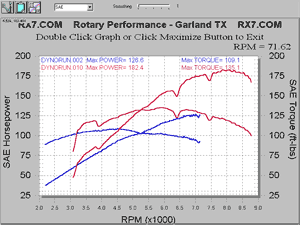|
RX-8 Power: how powerful is the Renesis really?
We have all heard the magic disappearing horsepower numbers
from the marketing sources. The question we’d like to pose
isn’t “where did the horsepower disappear to”? Rather,
we’d like to ask, how much more power does the Renesis
make compared to it’s predecessor?
Keeping in mind that Mazda did not increase
the displacement of the Renesis, and they managed the amazing
engineering feat of reducing emissions at idle to 10% of
what the 13B-REW (the Renesis’ immediate predecessor) produces
at idle, and 15% of what the 13B-REW produces at cruising
speeds and loads.
The argument can be made that the Renesis produces higher
peak power because of its ability to rev much higher than
the old 13B. So to be fair, let’s compare the two powerplants
at the point where the old 13B is producing it’s maximum
hp. In this chart, that happens to be at 7000rpm. At this
point, the old 13B is making 125hp while the Renesis is
making 175hp. That is a 50hp difference which translates
to 40% more power (40% of 125hp = 50hp). For the sake of
full disclosure, the 2nd generation RX-7 tested here is
a 1991 with a fresh motor (less than 1000 miles), and the
RX-8 tested is a 2004 with about 800 miles.

Dyno chart comparing stock Renesis and the last generation
normally aspirated rotary engine found in an 1991 RX-7.
Click the above image for a closer look.
While we realize that 12 years has elapsed since the previous
generation normally aspirated 13B was last sold; that
there has been at least that amount of research and development
devoted to the Renesis, we should not lose sight that
Mazda is the only company actively perfecting and producing
the rotary engine.
And we are ecstatic that the rotary is back.
Next, finding more power in the Renesis. Stay tuned. |